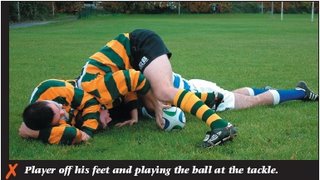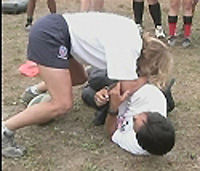The post on Coaching the Seal solicited a couple of passionate comments.
Personally, i think the wide range of styles implemented on the pitch is one of the greatest things about our game, and I especially enjoy watching matches where one team implements a different set of tools and strategies than the other.
I thought I'd do a little research as to how the Laws of the Game directly relate to this issue. I'm but a lowly emergency b-side ref, so if there is a Big Time Referee out there who can give us some insight on the topic, feel free to chime in.
The complete 2006 Laws of the Game can be found at the IRB web site .
It seems there are a couple of laws that come into play when more than just one player winds up on the ground in a ruck situation.
Law 16 ... Tackle: Ball carrier Brought to the Ground
Law 17 .... Ruck
OBG is absolutely correct regarding rucking with the head above the shoulders. It is explicitly spelled out in Law 17. HOWEVER, its unclear if the player sealing would qualify as a "rucker". Since they are not involved in the act of "rucking", it seems like they would not.
The following images depicts the behavior by support players that is explicitly forbidden at the tackle (I snipped these from the complete Laws of the Game)...

Compare this to this screen capture from the video:
Hmmm. Neither of these photos, nor any in the Laws, seem to map exactly to what Kathy's coaching in the video. Maybe it's BRIDGING. Yeah, that's it!
A text search of the entire 180 page PDF document did not reveal the word bridge or bridging anywhere in the document. Is there no longer a reference to it? Is bridging no longer illegal? Anyone know?
I WAS able to find the term "Flying Wedge" under Chapter 10, Foul Play.
‘Flying Wedge’ The type of attack known as a ‘Flying Wedge’ usually happens near the goal line, when the attacking team is awarded a penalty kick or free kick. The kicker tap-kicks the ball and starts the attack, either by driving towards the goal line or by passing to a team mate who drives forward. Immediately, team mates bind on each side of the ball carrier in a wedge formation. Often one or more of these team mates is in front of the ball carrier. A ‘Flying Wedge’ is illegal.
Penalty: Penalty Kick at the place of the original infringement.
Interesting stuff, these laws.
Tuesday, November 21, 2006
Laws of the Game: Sealing? Bridging? Flying Wedge?
Posted by
Just call me coach....
at
4:57 PM
![]()
Labels: Laws_of_the_Game | Hotlinks: DiggIt! Del.icio.us
Subscribe to:
Post Comments (Atom)









3 Comments:
I wouldn’t say that I am in any way shape or form a High Level Ref, but I have been a referee in the PRU for 5 years now and have tried to stay up with the varying trends of play-- and as a coach, I try and keep my players up with those trends to stay competitive. With respect to the "bridge" or the "long body ruck" which OBG discussed as turteling, depending the referee, he/she might be looking for various things at the break down, but the overall theme must be Opportunity-- is there an opportunity for the defense to compete for the ball? And is that opportunity being spoiled by something being done by the oncoming attackers/ruck? That opportunity may be something as simple as giving a target or an area to defend against, something to push, something ruck, or has the attack completely taken the opportunity away by bridging, as is seen in the pictures where the shoulders are not available to ruck against-- some referees (as was seen at the College All Star Tournament this past summer) may want to see more than just shoulders and want to see the head looking up, or an opportunity for arm extension. With respects to the long body ruck, it becomes illegal when the carrier, turned ruck crawls or motions forward after the ruck has become formed-- mainly because he/she is no longer on their feet and by crawling forward, rather than the left or right, he/she is now obstructing play and the opportunity to ball. As a referee, who likes to see movement and see that the balls is available to be played, I welcome the seal, because now, I have less bodies fighting around the ball, I don’t have scrumhalves half way into a pile that can potentially come crashing down, and most of all-- I CAN SEE THE BALL and the HANDS IN.
I have heard numerous arguments that you cant defend against the seal, and the answer is getting to play, making the offensive tackle, and "pulling through." If you can make the tackle which puts the carrier on your side of the attack line, or at least the ball on your side, the seal becomes ineffective, If you can quickly get the play and get low in a traditional low body ruck, you can catch arms and shoulders and drive the seal off (or before it is formed) there by putting the carrier and the ball in your arena. And lastly, if the seal has formed, and has taken away any possibility of forming the ruck, there is not thing preventing the seal to come through-- pulling the seal towards you, or the player on the ground.
And yet another argument that is on the table with regards to this type of leach and seal or the long body or the power-up is that men's teams have been doing this form of ruck for years, and no ever really had a problem with it…? American rugby has for years been centered around the ruck, attacking channel one with as many forwards as it takes to bull your way down the field; the only difference now is that when women do it, as with most of the other concepts in rugby, women do it was such great precision and speed that spectators and coaches alike raise an eyebrow. I began coaching the leach and seal last year to my college women's team and the first comment I got from one of my seniors was "Coach, that how the boys play-- just lying on top of each other." I had to explain to her that I was not coaching lying on top, or bridging the ball, and it was not necessary to send 5 forwards crashing into the pile.
I have run into the interpretation that if a support player is holding onto a player on the ground, in any way, the support player has technically "lost their feet" as well in the ruck. I have seen teams, including my own, penalized for this.
I am very much interested in the bridging vs. sealing vs. whatever debate. I do worry about teaching this tactic to rookie college players, particularly as it makes the head vulnerable to contact. Obviously correct head position is key, but I'm not sure if it's something I am ready to eagerly adopt.
The game is changing though and soon I suspect college coaches will either go to a seal or bridge or lose serious competitive advantage.
I was always taught that the law states that if a player loses their balance in a ruck, then they are within their rights to support themself by holding onto the player on the ground. This is where "bridging" simply becomes "oops...I lost my balance" ;).
As for the head being exposed, in my own experience as a scrumhalf and therefore a rather small player, I am normally not big and strong enough to ruck normally over a 200 lb prop in the event that I need to secure a ball - it is only through the "sealing" technique that I am able to retain possession for my team. You're right, it is important to teach proper positioning in order to ensure that injury doesn't occur, but the same can be said for everything in rugby. Not only have I never been injured when using this technique, but when executed cleanly, I have also never been penalized, and never lost a ball even when holding off an entire pack of giants. Though I don't believe this is the ONLY rucking technique which should be used, I certainly believe that any competitive rugby player can benefit by adding it to his or her toolbelt.
Post a Comment